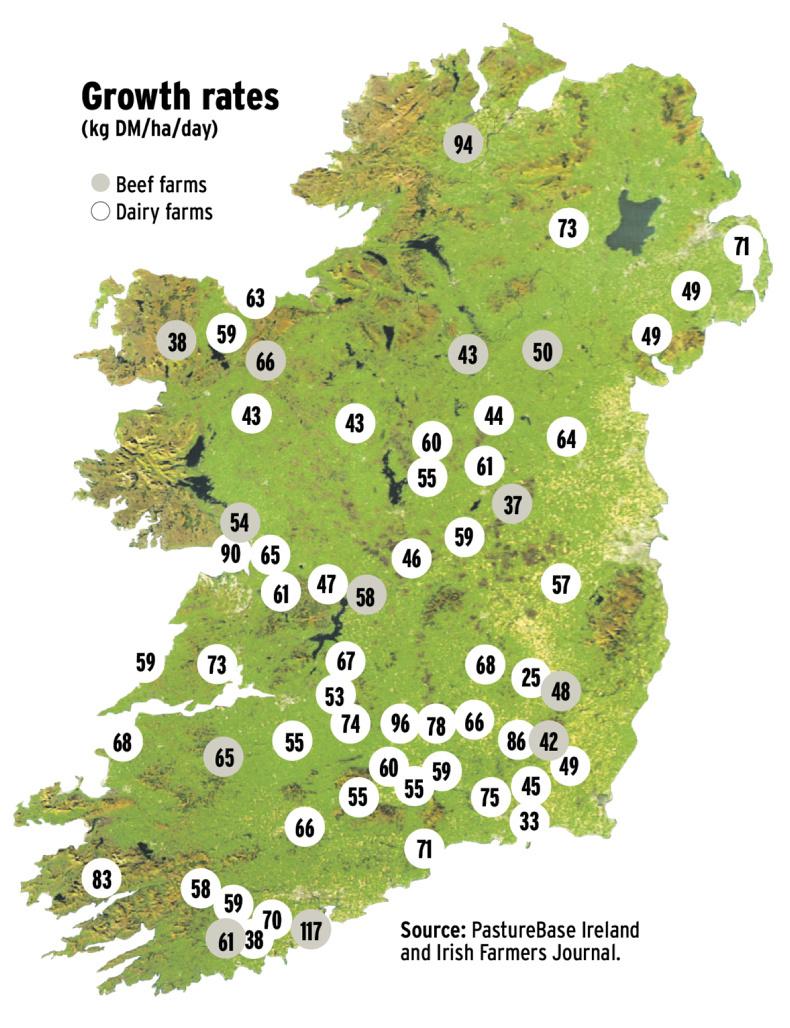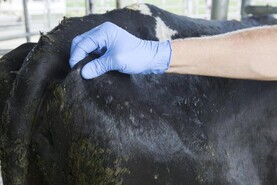Moisture deficit is having its effect right around the country this week with the exception of some areas in the west and northwest.
Fields that have been grazed recently are showing very little growth along with any covers under 500kg/ha as the low leaf cover expose these fields more to the dry conditions.
Rain is forecast before the weekend which will hopefully help keep grass growing but may not be enough to see any significant jump in growth.

So what should your plan be? Walk the farm every five days, making decisions based on the growth over the previous five days and what you predict it may be over the next five. If there is rainfall, it may increase but if you don’t growth will only drop.

This will give you a chance to identify any deficits that may arise early and intervene. If your cover/LU has fallen below 140kg/ha or pre-grazing yields become lower than 1,200kg/ha you need to make sure demand is less than growth.
Act fast by increasing supplementation or grazing a field intended for silage up to a cover of 3,200kg DM/ha after which the utilisation is to low and feeding high-quality bales is a better option.
Where the decision is taken to graze a paddock originally intended for silage you should try to minimise the hit to production. Stagger the grazing of such covers – graze good-quality swards by day and the higher covers by night. Pre-mowing will also help increase utilisation of the sward.
Nitrogen fertiliser application should continue in a moisture deficit until 25 days have passed without rain.
Avoid topping as it’s wasting feed available to livestock and will also inhibit regrowth.
Teagasc Curtins Farm, Co Cork
Growth is well back over the last week and rain is badly wanted. We are grazing a 1,500kg/ha cover at the moment but everything coming behind is back around 1,100kg/ha. Concentrates have been increased to 4kg which has help drop our demand to 51kg/day. If growth stays at 52kg we should be able to maintain the grass cover. However, we have two paddocks with covers of 2,500kg that we may have to graze depending on how much rain comes over the next day or so. Breeding is going well, all but three cows being bred in the first three weeks. We are going into week five now and getting a few repeats but nothing major.
Caherconlish, Co Limerick
The drop of rain on Sunday helped green up the farm as growth had dropped back and grass was stressed. We have been going with a light coat of slurry on paddocks after grazing which has also helped keep moisture in the ground and grass growing. Fertiliser is going out in the form of protected urea with sulphur. We are targeting covers seven days away from grazing when spreading. Breeding is going well with 85% of the cows bred. A few late calves and cows in poor condition are on once-a-day milking.
Carrowmore, Co Mayo
We are in a good position here at the moment. We’re just getting enough rain to get by, 10ml was recorded over the last week. A lot of our farm was reseeded last year and we find those paddocks are great to keep growing. Pre-grazing yields are at 1,500kg/ha and cows are milking well. We were 19 days into the breeding season on Wednesday and have 86% of the herd served. We are using tail paint as heat detection and are keeping it topped up twice a week. After the three weeks the activity will drop, so we will introduce teaser bulls along with the tail paint to help catch any repeats.
Moisture deficit is having its effect right around the country this week with the exception of some areas in the west and northwest.
Fields that have been grazed recently are showing very little growth along with any covers under 500kg/ha as the low leaf cover expose these fields more to the dry conditions.
Rain is forecast before the weekend which will hopefully help keep grass growing but may not be enough to see any significant jump in growth.

So what should your plan be? Walk the farm every five days, making decisions based on the growth over the previous five days and what you predict it may be over the next five. If there is rainfall, it may increase but if you don’t growth will only drop.

This will give you a chance to identify any deficits that may arise early and intervene. If your cover/LU has fallen below 140kg/ha or pre-grazing yields become lower than 1,200kg/ha you need to make sure demand is less than growth.
Act fast by increasing supplementation or grazing a field intended for silage up to a cover of 3,200kg DM/ha after which the utilisation is to low and feeding high-quality bales is a better option.
Where the decision is taken to graze a paddock originally intended for silage you should try to minimise the hit to production. Stagger the grazing of such covers – graze good-quality swards by day and the higher covers by night. Pre-mowing will also help increase utilisation of the sward.
Nitrogen fertiliser application should continue in a moisture deficit until 25 days have passed without rain.
Avoid topping as it’s wasting feed available to livestock and will also inhibit regrowth.
Teagasc Curtins Farm, Co Cork
Growth is well back over the last week and rain is badly wanted. We are grazing a 1,500kg/ha cover at the moment but everything coming behind is back around 1,100kg/ha. Concentrates have been increased to 4kg which has help drop our demand to 51kg/day. If growth stays at 52kg we should be able to maintain the grass cover. However, we have two paddocks with covers of 2,500kg that we may have to graze depending on how much rain comes over the next day or so. Breeding is going well, all but three cows being bred in the first three weeks. We are going into week five now and getting a few repeats but nothing major.
Caherconlish, Co Limerick
The drop of rain on Sunday helped green up the farm as growth had dropped back and grass was stressed. We have been going with a light coat of slurry on paddocks after grazing which has also helped keep moisture in the ground and grass growing. Fertiliser is going out in the form of protected urea with sulphur. We are targeting covers seven days away from grazing when spreading. Breeding is going well with 85% of the cows bred. A few late calves and cows in poor condition are on once-a-day milking.
Carrowmore, Co Mayo
We are in a good position here at the moment. We’re just getting enough rain to get by, 10ml was recorded over the last week. A lot of our farm was reseeded last year and we find those paddocks are great to keep growing. Pre-grazing yields are at 1,500kg/ha and cows are milking well. We were 19 days into the breeding season on Wednesday and have 86% of the herd served. We are using tail paint as heat detection and are keeping it topped up twice a week. After the three weeks the activity will drop, so we will introduce teaser bulls along with the tail paint to help catch any repeats.








 This is a subscriber-only article
This is a subscriber-only article










SHARING OPTIONS: